Research - (2021) Volume 9, Issue 1
Knowledge and Awareness on Risk Factors of Breast Cancer Among Post-Menopausal Women
Aishwarya S, Vishnu Priya V* and Gayathri R
*Correspondence: Vishnu Priya V, Department of Biochemistry, Saveetha Dental College and Hospitals, Saveetha Institute of Medical and Technical Sciences (SIMATS), Saveetha University Tamilnadu, India, Email:
Abstract
Breast cancer is the most common female cancer worldwide and is the second most diagnosed cancer in Indian women. In India, the number of new breast cancer cases is about 115,000 per year and this is expected to rise to 250,000 new cases per year by 2015. It needs to be noted that breast cancer is leading in the age groups of 15–34 years which is a cause of concern as this denotes the need for educative and awareness programs targeting younger members of the society, to implement early practices of breast examination. The aim of this study is to evaluate the awareness on risk factors of breast cancer among post-menopausal women. A self-structured questionnaire was designed and consisted of questions regarding the awareness on various risk factors of breast cancer. The questionnaire was distributed through an online forum. The study population included 100 menopausal women belonging to age group of 40-70 years. The questions were carefully studied and the corresponding answers were marked by the participants. The data were collected and statistically analyzed using SPSS software. Most women were aware about breast cancer; however, they were not aware about the risk factors and symptoms of breast cancer completely. It is noted that only 28% of the women were aware about the breast self-examination and 39% of them are under regular check up by doctor for breast evaluation. Within the limitations of the study, we can conclude though the study group population women were aware about breast cancer, they were not aware about the risk factors, symptoms, and treatment. Health education camps, breast selfexamination education, seminars may be conducted to create awareness on risk factors of breast cancer among post-menopausal women.
Keywords
Breast cancer, Menopausal women, Female cancer, Hormonal contraceptives
Introduction
Cancer incidence and mortality are growing at a vigorous pace across the globe and this transition is most striking among emerging economies. Globally, one-fourth (25%) i.e. 2.1 million cases of all female cancer diagnosed in 2018 were of breast cancer [1]. In India, cancer prevalence is estimated around 2.5 million, with over 0.8 million new cases and 0.5 million deaths occurring each year [2]. The common sites for cancer in India for females are cervix, breast, and oral cavity. Breast cancer accounts for 19%–34% of all cancer cases among women in India [3]. The incidence of breast cancer is rising in India (22.9%) and is now the second most diagnosed cancer in women after cervical cancer [4]. The number of new breast cancer cases is about 115,000 per year and this is expected to rise to 250,000 new cases per year by 2015 [5]. The peak occurrence of breast cancer in developed countries is above the age of 50 years, as compared to India, where it occurs in a younger age group [6].
Although many risk factors may increase the chance of having breast cancer, it is not yet known just how some of these risk factors cause cells to become cancerous [7,8]. Risk factors can be divided into non-modifiable risk factors and risk factors related to lifestyle choices [9,10]. Unmodifiable risk factors are gender, age, genetic factors, family history, personal history of breast cancer, dense breast tissue, menstrual periods, breast radiation early in life, and treatment with diethylstilbestrol [11-13]. Risk factors related to lifestyle are not having pregnancy history or pregnancy at late ages, recent use of birth control pills, using hormone therapy after menopause, not breast-feeding, alcohol, being overweight or obese, lack of exercise, and induced abortion [14].
A study in rural Maharashtra found that most of the breast cancer cases were confined to women aged 40–49 years, home makers and upper economic strata groups. Further, this study found breast cancer risk was 8 times higher among unmarried women, 3 times more among nulliparous women, 2 times more likely among post-menopausal women, 10 times more among those who had never breastfed, 1.5 times higher among women who were exposed to hormonal contraceptives and 4.5 time more likely among women with history of ovarian diseases than in comparison to married, non-nulliparous, premenopausal, women who ever breastfed, who have not been exposed to hormonal contraceptives, and women without any ovarian diseases respectively [15]. The aim of this study is to evaluate the awareness on risk factors of breast cancer among post-menopausal women.
Materials and Methods
A cross sectional questionnaire-based study was carried out among post-menopausal women in Chennai. A self-structured questionnaire was designed with the first part of the questionnaire consisted of participants' details such as name and age. The second part consisted of questions regarding their awareness on various risk factors of breast cancer. The questionnaire was distributed through an online link. The study population included 100 menopausal women belonging to age group of 40-70years. Simple random sampling methodology was employed. The participants were explained about the purpose of the study. The questions were carefully studied, and the corresponding answers were marked by them. The data were collected and statistically analyzed using SPSS software.
Results and Discussion
Out of 100 candidates, 27% belonged to age group of 40-50 years, 35 % belonged to 51-60 years and 38% of candidates belonged to 61-70 years (Figure 1). 91% of the women were aware about breast cancer (Figure 2). On analysing their awareness about the detection of breast cancer 15% of them were aware that biopsy is the only definitive way of diagnosing breast cancer and 34% claimed that mammogram is the best way of detecting the breast cancer and 17% claimed BSE could be the best way of detection of breast cancer (Figure 3). Most women believed that excess tobacco usage (35%) and alcohol intake (19%) is the major risk factor for breast cancer and 28% believe that high radiation exposure could be the possible risk factor and 18% believe that previous history of another cancer could be the possible risk factor (Figure 4).
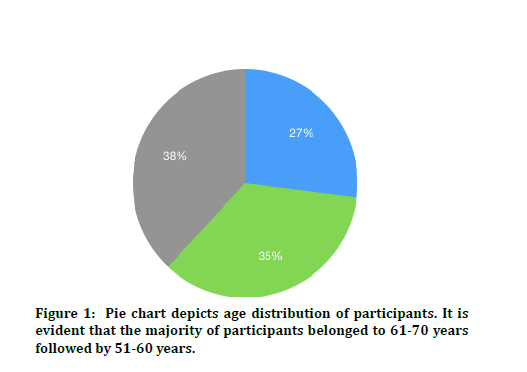
Figure 1: Pie chart depicts age distribution of participants. It is evident that the majority of participants belonged to 61-70 years followed by 51-60 years.
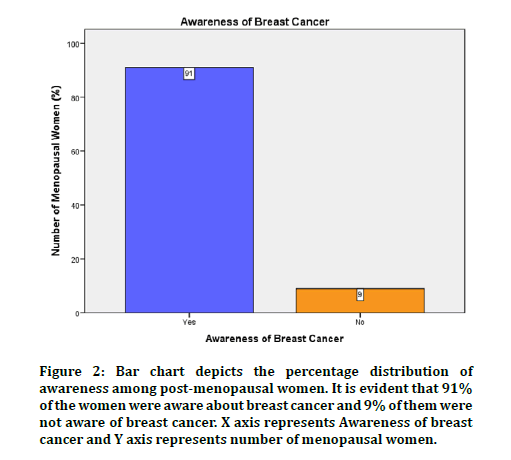
Figure 2: Bar chart depicts the percentage distribution of awareness among post-menopausal women. It is evident that 91% of the women were aware about breast cancer and 9% of them were not aware of breast cancer. X axis represents Awareness of breast cancer and Y axis represents number of menopausal women.
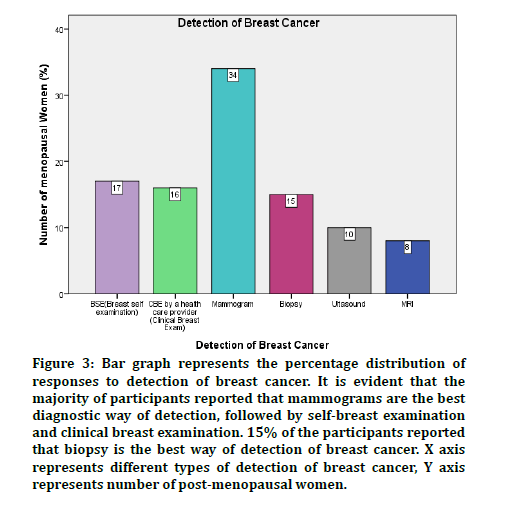
Figure 3: Bar graph represents the percentage distribution of responses to detection of breast cancer. It is evident that the majority of participants reported that mammograms are the best diagnostic way of detection, followed by self-breast examination and clinical breast examination. 15% of the participants reported that biopsy is the best way of detection of breast cancer. X axis represents different types of detection of breast cancer, Y axis represents number of post-menopausal women.
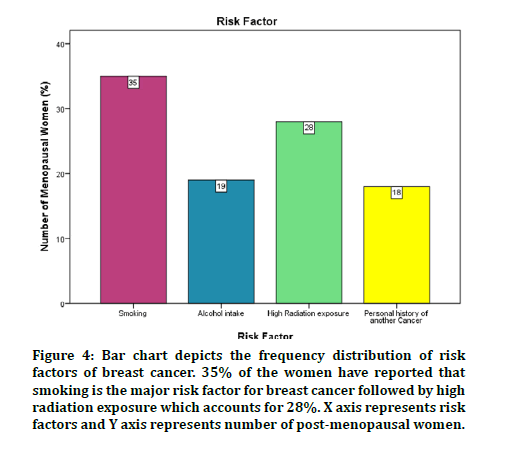
Figure 4: Bar chart depicts the frequency distribution of risk factors of breast cancer. 35% of the women have reported that smoking is the major risk factor for breast cancer followed by high radiation exposure which accounts for 28%. X axis represents risk factors and Y axis represents number of post-menopausal women.
On analysing the most common symptoms of breast cancer 25% of the women claim that nipple aversion could be the common symptoms, while 21% claim it an unusual pain of breast, 15% believes it to be unusual discharge and only 11% of the women were aware that breast lump could be the first sign of symptom for breast cancer (Figure 5). Only 28% of the women were aware of breast self-examination and 72% were not aware about the BSE. 39% of the women were under regular check up by a doctor for prevention of breast cancer (Figure 6). 39% of the women were under regular check up by a doctor in order to identify any abnormalities in their breast (Figure 7). Figure 8 shows how often we should examine the breast. It is evident that 46% of them never examine their breast at all and 27% of them do it on a weekly basis and 11% of them do it once every month.
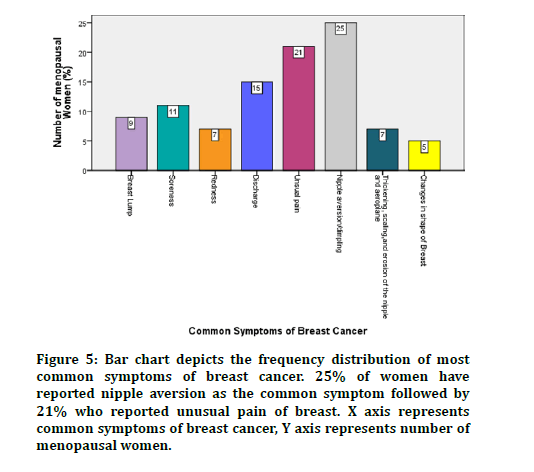
Figure 5: Bar chart depicts the frequency distribution of most common symptoms of breast cancer. 25% of women have reported nipple aversion as the common symptom followed by 21% who reported unusual pain of breast. X axis represents common symptoms of breast cancer, Y axis represents number of menopausal women.
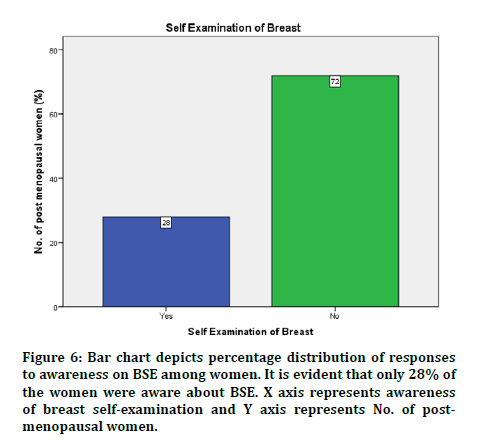
Figure 6: Bar chart depicts percentage distribution of responses to awareness on BSE among women. It is evident that only 28% of the women were aware about BSE. X axis represents awareness of breast self-examination and Y axis represents No. of postmenopausal women.
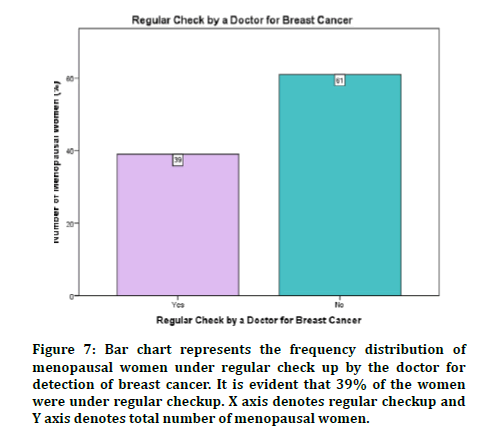
Figure 7: Bar chart represents the frequency distribution of menopausal women under regular check up by the doctor for detection of breast cancer. It is evident that 39% of the women were under regular checkup. X axis denotes regular checkup and Y axis denotes total number of menopausal women.
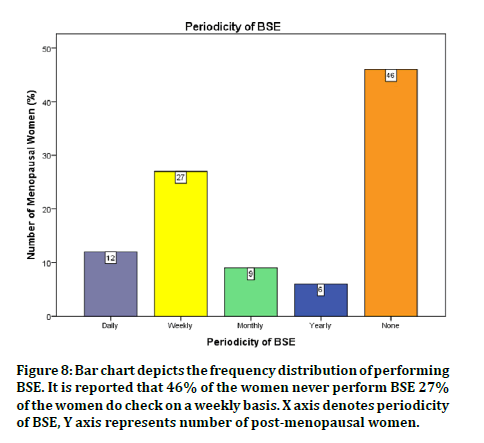
Figure 8: Bar chart depicts the frequency distribution of performing BSE. It is reported that 46% of the women never perform BSE 27% of the women do check on a weekly basis. X axis denotes periodicity of BSE, Y axis represents number of post-menopausal women.
This study revealed that the women were aware about causes but were not aware about the symptoms of breast cancer, its risk factors and about the self-examination of breast which is the basis for early diagnosis and prevention of breast cancer. In this study 91% of the women were aware about breast cancer but this does not agree with the study done by Ranjan et al where he reported that breast cancer knowledge among the women in the study area was poor. Only less than half of the women were aware of breast cancer [16]. A review of the literature reveals low breast cancer literacy about risk factors among Indian women, irrespective of their socioeconomic and educational backgrounds, with little correlation between awareness levels and strength of evidence of the risk factor which is in consent with our study [17]. It is important to note that though half of the women were aware of breast cancer, the knowledge of different symptoms was low among these women. In this study majority women claimed that nipple aversion was the most common symptoms of breast cancer followed by unusual pain and discharge from the breast, very few were aware that change in breast shape, breast lumps, soreness could also be a possible symptom for early detection of breast cancer. This is agreement with the study done by Shinde et al, Mumbai also found similar results with an exceptionally low percentage of women saying the change in shape/size of breast, discharge from nipple and inverted nipple as danger signs of breast cancer [18]. The study by Somdatta et al. [19] also found similar outcomes in a resettlement colony of Delhi. In this study, better knowledge of danger signs or symptoms of breast cancer is observed among higher educated and working women than lower educated and not working women respectively. Breast cancer means losing one’s breast(s) was the most common misconception among women.
The knowledge and practice of BSE is low in this study which is in consent with the study done by Alwan et al. were he reported that only 39.6% reported ever hearing of BSE and a mere 14% and 7% respectively knew its correct frequency and timing [20]. A cohort study in Finland [21] and a case–control study in Canada [22] suggested BSE be beneficial at all ages. Awareness and practice of BSE can help women to seek medical care and advice immediately. As the source of knowledge is also especially important, most women were educated by health personnel. Hence, health personnel should be both knowledgeable and trained properly regarding signs and symptoms of the disease. As education of women itself is a factor which can improve the knowledge, emphasis should be laid on women literacy.
Conclusion
The study concluded that the awareness of breast cancer in our study population was good. The knowledge and awareness regarding BSE were poor which is utmost important for early detection and in reduction of mortality. Within the limitations of the study, we can conclude though the study group population women were aware about breast cancer, they were not aware about the risk factors, symptoms and treatment. Health education camps, brease self-examination education, seminars may be conducted to create awareness on risk factors of breast cancer among post - menopausal women.
References
- Bray F, Ferlay J, Soerjomataram I, et al. Global cancer statistics 2018: GLOBOCAN estimates of incidence and mortality worldwide for 36 cancers in 185 countries. Cancer J Clin 2018; 68:394–424.
- Ferlay J, Soerjomataram I, Ervik M, et al. Estimated cancer incidence, mortality and prevalence worldwide in 2012. World Health Organization 2012.
- Fitzmaurice C, Dicker D, Pain A, et al. The global burden of cancer 2013’, JAMA Oncology 2015; 1:505–527.
- Ibrahim AS, Khaled HM, Mikhail NN, et al. Cancer incidence in Egypt: Results of the national population-based cancer registry program. J Cancer Epidemiol 2014; 437971.
- Parkin DM, Bray F, Ferlay J, et al. Global cancer statistics 2002. Cancer J Clin 2000; 55:74–108.
- Sharma K, Costas A, Shulman LN, et al. A systematic review of barriers to breast cancer care in developing countries resulting in delayed patient presentation. J Oncol 2012; 22:121873.
- https://shop.lww.com/Pathophysiology-Made-Incredibly-Easy/p/9781496398246
- Tarver T. Cancer facts & figures 2012. American cancer society (ACS). J Consumer Health Internet, 2012; 66:366–367.
- Gallucci BB. Selected concepts of cancer as a disease: From the Greeks to 1900. Oncology Nursing Forum 1985; 12:67–71.
- Fauci AS. Harrison’s principles of internal medicine. McGraw-Hill, Medical Publishing Division New York 2008.
- Kumar V, Cotran RS, Robbins SL. Basic Pathology. W.B. Saunders Company 1997.
- https://www.springer.com/gp/book/9783319406176
- Wolf AM, Wender RC, Etzioni RB, et al. American cancer society guideline for the early detection of prostate cancer: Update. Cancer J Clin 2010; 60:70–98.
- Henderson IC. Risk factors for breast cancer development. Cancer 1993; 71:2127–2140.
- Mohite VR, Pratinidhi AK, Mohite RV. Reproductive risk factors and breast cancer: a case control study from rural India. Bangladesh J Med Sci 201; 14:258–264.
- Prusty RK, Begum S, Patil A, et al. Knowledge of symptoms and risk factors of breast cancer among women: a community based study in a low socio-economic area of Mumbai, India. BMC Women’s Health 2020; 20:1-2.
- Gupta A, Shridhar K, Dhillon PK. A review of breast cancer awareness among women in India: Cancer literate or awareness deficit?’ Eur J Cancer 2015; 51:2058–2066.
- Shinde S, Kadam S. Breast cancer awareness among women in Vikhroli: a suburban area of Mumbai, Maharashtra, India. Int J Community Med Public Heal 2016; 3:2281–2286.
- Somdatta P, Baridalyne, N. Awareness of breast cancer in women of an urban resettlement colony. Indian J Cancer 2008; 45:149–153.
- Alwan NA, Al Attar WM, Eliessa RA, et al. Knowledge, attitude and practice regarding breast cancer and breast self-examination among a sample of the educated population in Iraq. Eastern Mediterranean Health J 2012; 2012:337–345.
- Gastrin G, Miller AB, To T, et al. Incidence and mortality from breast cancer in the mama program for breast screening in Finland 1973-1986. Cancer 1994; 73:2168–2174.
- Harvey BJ, Miller AB, Baines CJ, et al. Effect of breast self-examination techniques on the risk of death from breast cancer. Canadian Med Assoc J 1997; 157:1205–1212.
Author Info
Aishwarya S, Vishnu Priya V* and Gayathri R
Department of Biochemistry, Saveetha Dental College and Hospitals, Saveetha Institute of Medical and Technical Sciences (SIMATS), Saveetha University Tamilnadu, Chennai, IndiaCitation: Aishwarya S, Vishnu Priya V, Gayathri R, Knowledge and Awareness on Risk Factors of Breast Cancer Among Post-Menopausal Women, J Res Med Dent Sci, 2021, 9 (1): 72-76.
Received: 23-Sep-2020 Accepted: 10-Dec-2020
